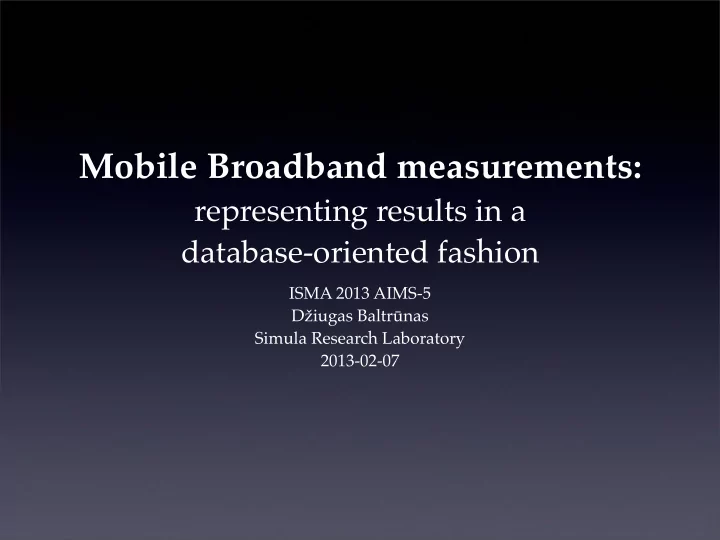

Mobile Broadband measurements: representing results in a database-oriented fashion ISMA 2013 AIMS-5 D ž iugas Baltr ū nas Simula Research Laboratory 2013-02-07
Environment • Few hundreds of geographically spread nodes equipped with 2+ 3G connections plus optional WiFi and LAN. • Each node conducts multiple measurements of Mobile Broadband Networks to address resilience, robustness and performance. • Different types of measurements: RTT, one-way delay, throughput, connectivity (ability to connect), etc. • A matrix of different protocols (e.g. TCP, UDP, ICMP), inter-arrival times, periodicity, packet sizes. • Useful metadata that is provided by the 3G USB modems (e.g. signal strength, RRC state, Cell ID, etc.).
Objectives • Continuous RTT measurement of 4 MBB networks on a single node with IAT of 1 second produces 60 sec * 60 min * 24 h * 4 networks * 2 records = 691200 rows of data per day not counting the metadata. • Different experiments measure different metrics and for each measurement there has to be a process to organize the data (write to a file, sync to a server, do post-processing actions and archive). • Real-time web visualization frontend needs to access the fresh data from all nodes of all networks frequently and fast. • Historical data needs to be easily accessed for post-processing (e.g. aggregation) and analysis.
Lessons learned • Usually it takes about the same time to write a measurement script and to set up the logged data flow properly. • Storing measurement results in text files quickly becomes a hassle from all perspectives. • There are static and dynamic properties of a node and a network as well as inventory items that often needs to be displayed together with measurement results. • Different data structures for different measurements makes the results hard to display, analyze, correlate and maintain.
Our approach • Organize the data in a relational database. • Relate the inventory (nodes, devices, SIM cards) with the measurement results, but store it in separate tables. • Abstract measurement data to a lowest common denominator and encode it in a unified format among different measurements. • Set up a shared infrastructure for collecting measurement results from the nodes, parsing the data and importing it into the database, relaxing the measurement script from worrying about the logged data flow. • If necessary, define a flexible configuration for a particular measurement so that the data can be imported into a measurement specific table for easier analysis.
Metadata • Some of the 3G USB modems working as serial devices expose additional PCUI serial port which can be used to execute AT commands or receive unsolicited reports while the PPP connection is active. It provides information such as mode (e.g. GSM, WCDMA), submode (e.g. EDGE, HSDPA, HSPA+), location information (LAC and Cell ID), camping network (in case of national roaming), RSSI and other changes on demand. • Modems with Qualcomm chipset provide Qualcomm Diagnostic Mode (QCDM) via yet another DIAG serial port. The protocol is proprietary, but there are some partial implementations such as libqcdm . Using QCDM, many different metadata, such as RRC state, can be extracted. • Serial port’s (e.g. /dev/ttyUSB0) is limited to one OS process, therefore metadata needs to be collected by the separate process which can broadcast it to other processes. We use ØMQ publisher-subscriber model. • Real-time metadata can be used by both measurement scripts (e.g. to wait for a certain RRC state before sending a ping packet) or collected and imported into the database for further analysis.
The relational model
������������������������ ���������������� ����������� �������������� �������� ������� ������������������� ������������������� ����������������� ����������������� �������������������������� ����������� ������������������� ������������������������ ����������������������� ���������������� ������ ������� ������� ����������������� ������������������� ����������� ����������� ������������������ �������������� �������������� ��������������������������� �������� ���������������������� ��������������������������� ������������������������ ����������� ������������� ������� ����������������������� ���������������������� ����������� ����������� ���������� ������� ����������������������� ������� ����������������������� ����������������������� ������������������ ������� ������������������ ������������������� ����������������������� �������������� ����������� ������ �������������������� ����������������� ������� �������������� ���� ���������������������� ������� ������������������ ������������������ �������������������� ������������������� �������������������� �������������������� ������������������ ���������������� ������ ������� ���������������� ����������� ����������� ���������������� �������������������� ������ ������� ������� ���������������������� ����������������������� ���������� ����������������������� ������ �������������������� �������������������������� ����������������� ������������������������ ������������� ��������������� ������� ����������������� ��������������������������� �������������� ������������� ����������� ����������� ������� ������������������� ������������������������� �������������������� ������������������� ����������������� ���������������� ������������������ ����������������� ������ ������ ������� ����������������������������� ������������������ �������
Recommend
More recommend